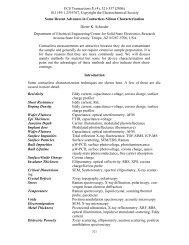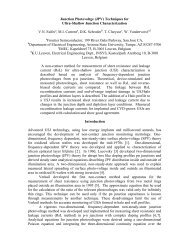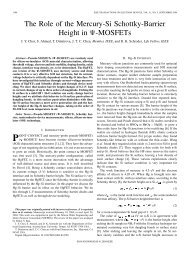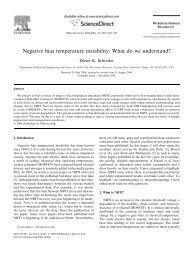Surface voltage and surface photovoltage - Dieter Schroder ...
Surface voltage and surface photovoltage - Dieter Schroder ...
Surface voltage and surface photovoltage - Dieter Schroder ...
You also want an ePaper? Increase the reach of your titles
YUMPU automatically turns print PDFs into web optimized ePapers that Google loves.
D K <strong>Schroder</strong><br />
Figure 5. (a) B<strong>and</strong> diagram for φ MS ≠ 0, but zero charges, (b) φ MS ≠ 0, Q ≠ 0 <strong>and</strong> ρ ox ≠ 0.<br />
V P<br />
+<br />
+<br />
+<br />
-<br />
-<br />
-<br />
p-type<br />
V P ≈ 0<br />
Light<br />
+<br />
+<br />
+<br />
p-type<br />
E Fn<br />
V P<br />
φ s<br />
E Fp<br />
E F<br />
(a)<br />
(b)<br />
Figure 6. (a) B<strong>and</strong> diagram with <strong>surface</strong> charge, (b) b<strong>and</strong> diagram with <strong>surface</strong> charge <strong>and</strong> strong illumination. The black circles represent<br />
electrons.<br />
with V ox given by<br />
F<br />
10 3<br />
10 2<br />
10 1<br />
100<br />
10<br />
1<br />
10 4 0 0.05 0.1 0.15<br />
∆ =0<br />
0.2<br />
Si, T=300 K<br />
V ox = Q/C ox =−Q S /C ox (13)<br />
where Q is the <strong>surface</strong> charge density <strong>and</strong> Q S the<br />
semiconductor charge density.<br />
The <strong>voltage</strong>s in the dark <strong>and</strong> under intense illumination<br />
(φ S → 0) are given by<br />
V P,dark = V FB + V air + Q/C ox + φ s<br />
φ s<br />
(V)<br />
Figure 7. Normalized <strong>surface</strong> electric field, F , function versus<br />
<strong>surface</strong> potential as a function of normalized excess carrier density<br />
or light intensity.<br />
electric field or constant F . Hence as n increases, the<br />
<strong>surface</strong> potential decreases, because the locus of the F –φ s<br />
plot is along a horizontal line such as the dashed line. It<br />
is obvious from figure 7 that the <strong>surface</strong> potential decreases<br />
with increasing light-generated excess carriers. In the limit<br />
of intense illumination, φ s → 0 <strong>and</strong> the semiconductor<br />
approaches flatb<strong>and</strong>.<br />
The probe potential is given by<br />
V P = V FB + V air + V ox + φ s (12)<br />
V P,light = V FB + V air + Q/C ox . (14)<br />
The charge density Q remains constant during the<br />
measurement, regardless of illumination, <strong>and</strong> the change in<br />
the <strong>surface</strong> <strong>voltage</strong> becomes<br />
5. Applications<br />
V P = V P,dark − V P,light ≈ φ s . (15)<br />
5.1. Minority carrier diffusion length<br />
A major application of SPV is the measurement of minority<br />
carrier diffusion length, even though the minority carrier<br />
diffusion length plays a negligible role in most integrated<br />
circuits (ICs) consisting of MOS devices. Then why measure<br />
the minority carrier diffusion length? The reason that minority<br />
R20








